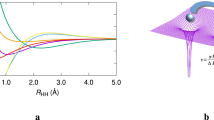Abstract
Replacing integer atomic numbers representing nuclear charges by continuous variables has already provided some rigorous quantum chemical relations between real molecules, using a formal interpolation through non-physical abstract molecules of continuously varying nuclear charges. Extending this approach to the more general “universal molecule” model, where all discrete parameters of molecules are generalized and replaced by continuous variables, provides further relations, actually interconnecting all real molecules through abstract, non-physical “molecules,” involving, for example, non-integer number of electrons. One simplifying idea of this model is the so-called “reference cluster,” originally defined for isoelectronic systems of a fixed number N of nuclei, where each nucleus is replaced by a possibly fictive nucleus with a nuclear charge equal to the average of the N nuclear charges. Based on the earlier results, some new relations are derived interrelating energies and some other properties of some real molecules, and also providing a unifying framework for the utilization of both symmetry and energy relations of the universal molecule model.
Similar content being viewed by others
References
Thirring W (1975) Acta Phys Austriaca (Suppl) 14:631–635
Narnhofer H, Thirring W (1975) Acta Phys Austriaca 41:281–287
Lieb EH, Simon B (1978) J Phys B 11:L537–L542
Mezey PG (1981) Theor Chim Acta 59:321–332
Mezey PG (1981) Int J Quant Chem Symp 15:279–285
Mezey PG (1982) Mol Phys 47:121–126
Mezey PG (1982) Int J Quant Chem 22:101–114
Mezey PG (1982) Chem Phys Lett 87:277–279
Mezey PG (1983) Int J Quant Chem 24:523–526
Mezey PG (1984) Can J Chem 62:1356–1357
Mezey PG (1984) J Chem Phys 80:5055–5057
Mezey PG (1985) J Am Chem Soc 107:3100–3105
Mezey PG (1985) Surf Sci 156:597–604
Mezey PG (1986) Int J Quant Chem 29:85–99
Mezey PG (1986) Int J Quant Chem 29:333–343
Otto P, Ladik J, Mezey PG (1987) J Math Chem 1:85–96
Cassam-Chenaï P, Chiaramello J-M, Mezey PG (2008) J Math Chem 44:981–987
Mezey PG (2007) AIP Conf Proc 963:513–516
Mezey PG (2012) AIP Conf Proc 1504:725–728
Mezey PG (2015) J Phys Chem A 119:5305–5312
Mezey PG (2015) Topological tools for the study of families of reaction mechanisms: the fundamental groups of potential surfaces in the universal molecule context. In: Alikhani E, Chauvin R, Lepetit C, Silvi B (eds) Applications of topological methods in molecular chemistry. Springer, New York (in press)
Mezey PG (1987) Potential energy hypersurfaces. Elsevier, Amsterdam
Mezey PG (1989) Topology of molecular shape and chirality. In: Bertran J, Csizmadia IG (eds) New theoretical concepts for understanding organic reactions. Kluwer Academic, The Netherlands
Acknowledgments
This study has been supported by the Canada Research Chair (CRC) Program of Canada, the Scientific Modeling and Simulation Laboratory (SMSL), and the Memorial University of Newfoundland.
Author information
Authors and Affiliations
Corresponding author
Additional information
Published as part of the special collection of articles “Festschrift in honour of P. R. Surjan”.
Rights and permissions
About this article
Cite this article
Mezey, P.G. Relations between real molecules through abstract molecules: the reference cluster approach. Theor Chem Acc 134, 134 (2015). https://doi.org/10.1007/s00214-015-1728-1
Received:
Accepted:
Published:
DOI: https://doi.org/10.1007/s00214-015-1728-1




